What's New
Displaying results 3501 - 3510 of 4052

Resource | Presentations,
Presentation on Estimating Resource Needs and Gaps for Harm Reduction In Asia at the IHRA’s 20th International Conference, 20-23 April 2009.
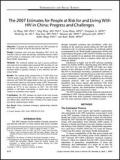
Resource | Publications,
The 2007 estimates for the number of people exposed to and infected with HIV in China utilized data newly available through expanded screening and surveillance, while also building on the experience gained during the 2003 and 2005 estimation work. As with past estimates, the workbook method recommended by the World Health Organization (WHO) and United Nations Program on HIV/AIDS (UNAIDS) was chosen as the most suitable for an epidemic still concentrated among certain subpopulations and in a situation where data are still relatively limited.
Populations at higher risk for HIV infection including female sex workers (FSWs), injecting drug users (IDUs), and men who have sex with men (MSM) still make up a large portion of new infections in 2007. However, there are signs that HIV is increasingly becoming a generalized epidemic as sexual contact replaces injecting drug use as the most common mode of transmission.
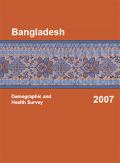
Resource | Publications,
The 2007 Bangladesh Demographic and Health Survey (BDHS) is a nationally representative sample survey designed to provide information on basic national indicators of social progress including fertility, childhood mortality, contraceptive knowledge and use, maternal and child health, nutritional status of mothers and children, awareness of AIDS, and domestic violence.
In addition to presenting the main findings from the 2007 BDHS on fertility, family planning, maternal & child health and nutrition, this report highlights the major changes that have taken place in Bangladesh's demographic and health situation since the previous BDHS surveys.
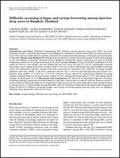
Resource | Publications,
Thailand's longstanding HIV epidemic among injection drug users (IDU) has been attributed, in part, to the Thai government's unwillingness to implement evidence-based HIV prevention interventions. This study was undertaken to examine risk factors for syringe borrowing among a community-recruited sample of Thai IDU.
A total of 238 IDU participated in this study; 66 (26.2%) were female, and the median age was 36.5 years. In total, 72 (30.3%) participants reported borrowing a used syringe in the past 6 months, with 47 (65.3%) of these individuals reporting multiple borrowing events. In multivariate analyses, syringe borrowing was positively associated with difficulty accessing syringes [adjusted odds ratio (AOR) = 2.46; 95% confidence interval (CI): 1.08–5.60] and injecting with other people on a frequent basis (AOR = 3.17; 95% CI: 1.73–5.83). Primary reasons offered for experiencing difficulty accessing syringes included being too far from syringe outlets (34.1%), pharmacies being closed (13.6%) and being refused syringes at pharmacies (9.1%).
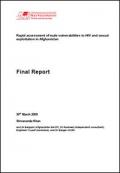
Resource | Publications,
Between October- November 2008, a small rapid assessment of male adolescent sexual exploitation and abuse, along with HIV risk and vulnerability among males who have sex with males, was conducted in Kabul, Kandahar and Maz-e-Sharif in Afghanistan. Preceding this, a scoping mission, a literature review, and a training workshop for the study teams were conducted.
The findings clearly demonstrate that, as in many other societies, sexual exploitation and abuse of highly vulnerable adolescent males, as well as consensual male-to-male sex exists in Afghanistan at significant enough levels to require an immediate response to the requirements of social justice, health and well-being of these males, and to ensure that the country does not develop a range of concentrated HIV epidemics among males who have sex with males, and highly vulnerable adolescent males over the next few years, adding already to the economic burden that already exists.
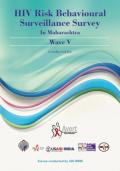
Resource | Publications,
Avert Society has been conducting BSS in seven priority districts of the Maharashtra state since 2004 and completed Wave V in 2009. The key objective of the study is to provide trends of knowledge and behaviour indicators so as to inform the program managers for the expansion of interventions leading to reduction in the transmission of HIV / AIDS and Sexually Transmitted Infections (STI) in the select districts of Maharashtra.
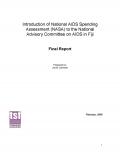
Resource | Publications,
This report supports the proposed UNDP financed technical assistance intended to introduce the National AIDS Spending Assessment methodology to the National Advisory Committee (NACA). Further development, implementation and institutionalization of the NASA methodology is expected to be lead by the NACA in order to standardize the classification of HIV and AIDS expenditures among all stakeholders. It is projected that NACA’s analysis of the tracked expenditures will enable valuable information to be disclosed that will influence the strategic allocation of future resources to Fiji’s HIV/AIDS initiative. Data generated through NASA can also be used to measure the nation’s commitment and effort, which is an important component of the UNGASS Declaration, and therefore will also help Fiji to address some of the gaps that currently exist in its UNGASS reporting.
This final report outlines the amount the Republic of the Fiji Islands spent on the HIV/AIDS initiative over the last two and a half years (2007-2009) from various local and external financing sources.
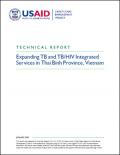
Resource | Publications,
This report provides an evaluation of an 18-month quality improvement intervention supported by the USAID-funded Quality Assurance Project (QAP) and its successor, the Health Care Improvement (HCI) Project, in Thai Binh Province of Vietnam. The province, located in the Red River’s Delta in northern Vietnam, has 1.8 million population, an annual TB case load of 1600–1800 cases, and an cumulative number of 2188 HIV-infected cases.
A number of activities to expand TB/HIV integration were carried out, including policy development; capacity building; maintaining the continuum of care; quality assurance of services; support for public and private partnerships; strengthening the monitoring and evaluation system; and conducting information, education, and communication activities.
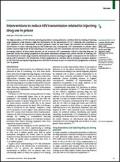
Resource | Reviews and Snapshots,
There is increasing evidence of what prison systems can do to prevent HIV transmission related to injecting drug use. In particular, needle and syringe programmes and opioid substitution therapies have proven effective at reducing HIV risk behaviours in a wide range of prison environments, without resulting in negative consequences for the health of prison staff or prisoners. The introduction of these programmes in countries with an existing or emergent epidemic of HIV infection among injecting drug users is therefore warranted, as part of comprehensive programmes to address HIV in prisons.
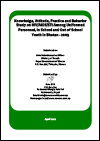
Resource | Publications,
About one-fifth of the HIV infections detected in Bhutan are among young women and men between the ages of 15-24 years. Young people are at special risk for STIs including HIV because they lack information, skills, health services and support that they need to need to make informed choices. Furthermore, uniformed personnel have also been seen as at-risk groups as about 13 percent of HIV cases detected in Bhutan so far have been among the uniformed services.





